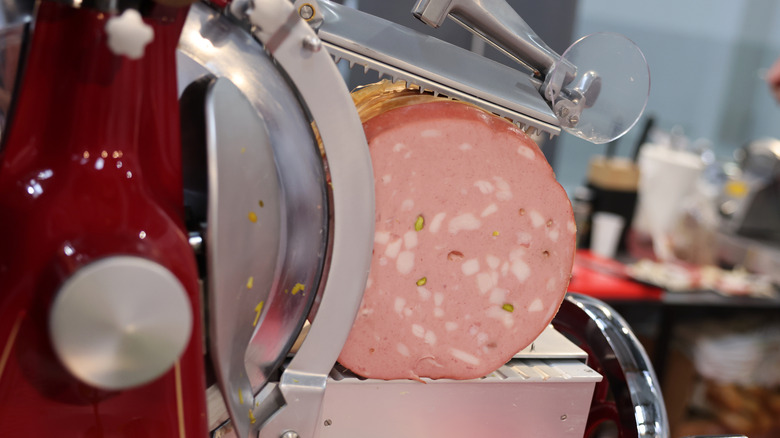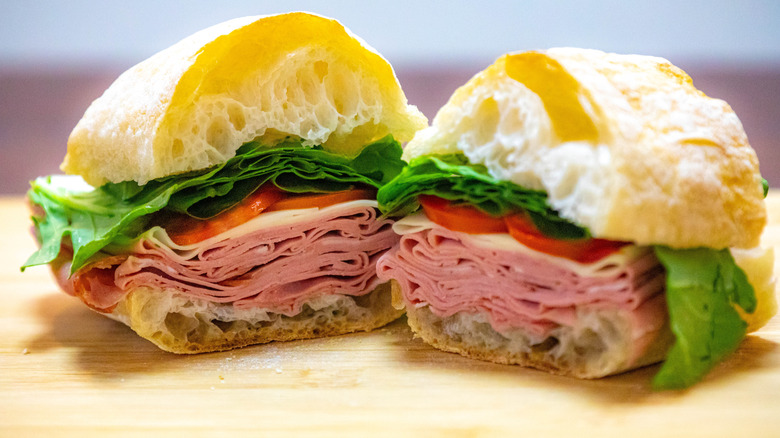The Difference Between Bologna And Mortadella
When you were a kid, there's a decent chance you grew up eating bologna sandwiches. They're extremely simple to make; you can add cheese, lettuce, or tomatoes at your leisure, depending on how big of a picky eater you were back then, but no matter what, the smooth, processed meat was the star of the show. Due to these lunches, bologna is one of those early words a kid learns which is spelled completely differently than it sounds — "a load of baloney" — and it's not what you might pick for a fancier deli sandwich as an adult. Imagine your surprise then, when you try the more under-the-radar mortadella for the first time and it seems notably similar to bologna. Is it the same?
In the sense that both are Italian sausages, they're similar, and their smooth, mild texture and light pink appearance certainly match up. The biggest difference between the two is that mortadella has cubes of fat separated from the pork, which are visible in its slices. It's also often spiced. Bologna is much more uniform looking, because the meat and the fat are completely mixed together into a consistent texture, and it's not typically spiced so its flavor is much milder. It may not sound like an enormous difference, but it does change how the two cold cuts are used, and how much you can do with each one.
Bologna is simple and homogenous
If you know your Italian cities (or if you've heard this fact before), you might already know that bologna is named after the city of Bologna in northern Italy. It was invented as a form of mortadella, and both are based on old forms of cured sausage which date back to ancient Rome. It's possible to find spiced bologna at the odd deli shop, but most modern bologna slices you'd find in grocery stores are more plain in comparison.
Despite being considered a kind of sliced ham, it can sometimes seem more ham-adjacent depending on what meat goes into it. Bologna can include a mixture if pork, chicken, turkey, and beef which is all blended together into a single batch of mystery meat until it's impossible to tell which is which, making it much like hot dog meat. For some extra flavor, many Southern U.S. bologna sandwiches are fried on the griddle instead of served cold. Perhaps because of how processed bologna becomes when its manufactured, it's sometimes considered not the healthiest. In truth, most cold cuts are filled with sodium and saturated fat, so bologna shouldn't be considered any worse than your sliced turkey. Despite those flaws, bologna still contains some vitamins, and it generally has less sodium than mortadella.
Mortadella is spiced and complex
Mortadella, sometimes referred to as gourmet bologna, is heterogeneous rather than homogeneous like bologna, which means the ingredients are separated instead of blended together. All of these separate ingredients — ground pork sausage, pork fat, and extras like peppercorns and pistachio — are visible in each slice of the deli meat. Importantly, unlike bologna, mortadella is guaranteed to be pork instead of a mix of different mystery meats. Due to these pale chunks of fat in the meat, and about 15% of mortadella is typically fat, the flavor of mortadella is fattier as well. The spices also add a more complex kick.
It may not surprise you to learn that mortadella was also invented in the city of Bologna, Italy. It's also based on ancient Roman meat-curing methods, but official guidelines for mortadella were established in Italy in 1661. To this day, official Bologna-made mortadella is protected by PGI status (short for "protected geographical indication"), which means the European Union has strict rules for what can be called real Bologna mortadella. Despite mortadella's Italian roots, it's become a globally popular cold cut. For example: São Paulo, Brazil has a local sandwich made with Dijon mustard, mayo, provolone cheese, and loads of mortadella which famously impressed Anthony Bourdain during one of his trips there.
How should you use mortadella versus bologna?
Sliced deli meats like bologna and mortadella are similar enough that you wouldn't ruin a sandwich by swapping one for the other, but there might be a noticeable change. Some chefs might balk at the idea of switching authentic mortadella for American bologna as a great compromise to nuanced flavor. Besides Anthony Bourdain's Brazilian sandwich, mortadella is a great option for a burrata sandwich, which is made up of pesto and burrata cheese (essentially a creamy mozzarella) on ciabatta bread. Mortadella is also typically a better choice for a charcuterie board, especially when you stuff the slices with pistachios. For cheese pairings, a common recommendation is Parmigiano Reggiano, a type of aged parmesan which also comes from Bologna, Italy.
On the other hand, bologna (especially if you're using store-bought American bologna) works better in simpler dishes. This can be as a protein in some sort of salad or egg sandwich, or you can fry it and add some lettuce and tomatoes for more texture. You probably don't need us to tell you that American bologna and American cheese is the classic "as simple as it gets" sandwich. If you're thinking of using bologna on a charcuterie board, you might need to take some steps yourself to spice it up, either by stuffing it or pairing it with a sharper cheese to offset its mild flavor, such as gorgonzola. As always, though, it depends on what you like.



